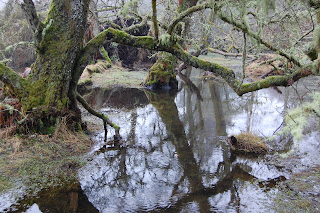It is sad that the Scottish Wildlife Trust, through Chairman Bantick, and SNH should behave in this way. Can it be that they are jealous of the success of the accidental return of the beavers to Tayside? They seem to think that the free beavers of the Tay are a threat to the success of their project.
So far as local tourism is concerned our beavers at Bamff have been a draw for the Cateran Trail and those that live along the Isla are bringing interested walkers to visit the banks of that river.
Here is the dam that Ronald Campbell of the Tweed Foundation claimed would be impassable to salmon, but which John Thorpe stated would be passable. I asked another fish scientist if the name of Professor Thorpe, uttered in the presence of Ronald Campbell, would be enough to cause him to vanish in a puff of smoke. This person assured me that it would.
Anyhow, here is that dam again: it would be a very weak salmon that could not make it up to the pool above.
My recent visit to Oregon and the Joe Hall Creek reminded me of the importance of gravel for salmon redds. As I look at the fast flowing waters below the dams here I see signs of development of the kind shown me by Stan Petrowski.
These two photographs might have been better if I had thought of taking a polaroid lens with me.
I like the effect, even if you cannot make out the gravels very well.
A point that Louise makes from time to time in the discussion of whether the Burnieshed Burn is a suitable place for salmon to breed in is that this was an agricultural ditch until 2007 when the beavers built the Ronald Campbell High Dam and the two other big dams downstream. The ditch is undergoing a process of rewilding with all that means for the return of complexity and enriched biodiversity.
Water tumbling through a spill way in one of the dams.
A real beaver swamp





The problem is, so much money has been used (not to mention the deaths of animals in their care) on the Knapdale project that they will take any opportunity to justify their position.
ReplyDeleteThe success of the Beavers on the Tay makes them look rather silly as also do the reasons given for removal of said Beavers.
I'm afraid I won't vanish in a puff of smoke!! While Prof Thorpe is a distinguished academic,I am an actual, practical, fisheries manager who works regularly with the effects of instream structures of all sorts on the distribution of Salmon and Sea-trout over a whole catchment and this sort of structure would be a problem to salmon (if the burn was salmon sized, which it is not) and to Sea-trout and Brown-trout. The point that has to be remembered is that it is the size of the "window of opportunity" (=frequency of suitable flows at the right time) that determines if fish get past a structure or not. The more difficult the structure, the smaller the "window". There's also seasonal variation in flows - some Autumns are wet, some are dry. This sort of structure, with no depth below it, will have no such "window" at all. It also has to be remembered that delay is dangerous for large fish in small burns and even structures that are passable cause delay - fatal if there are Otters around. All instream structures of any sort cause problems for fish migration, that is inevitable, it is the degree of difficulty that varies. I see this regularly when electric-fishing upstream and downstream of structures - numbers of juveniles upstream get reduced compared to those downstream. There's a huge number of examples of this sort of thing and the idea that Beaver dams are somehow magically different from weirs, bridge-aprons, fords, pipe-bridges etc etc. is a non-starter. Finally, just put yourself in the fish's place! What would you find easier for youself on your dangerous foray in to a burn - a clear run or an obstacle course?
ReplyDelete